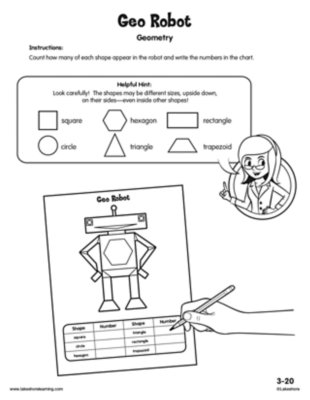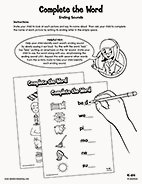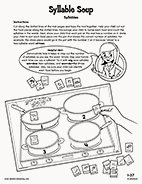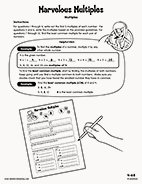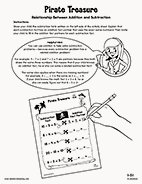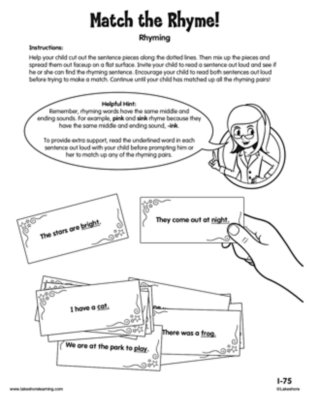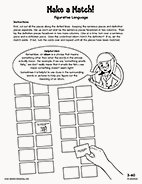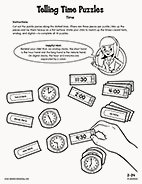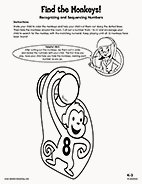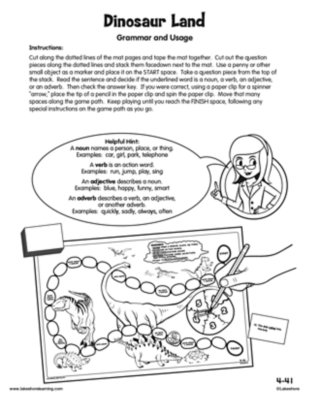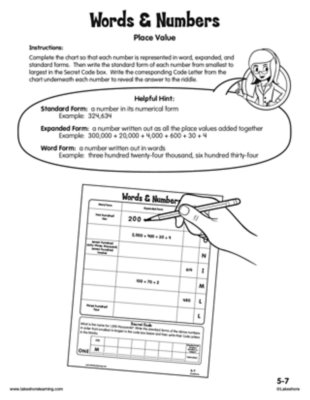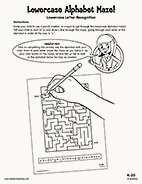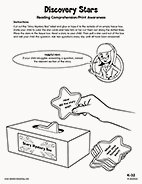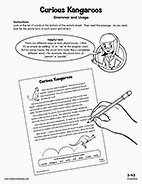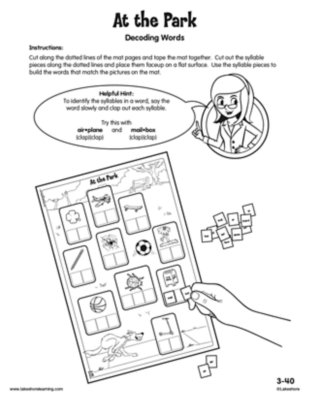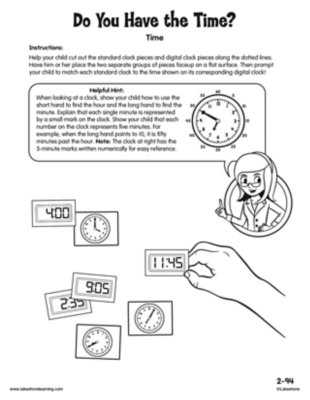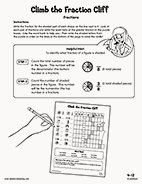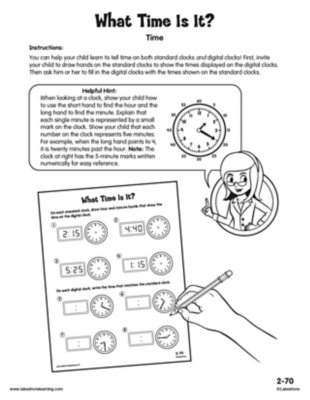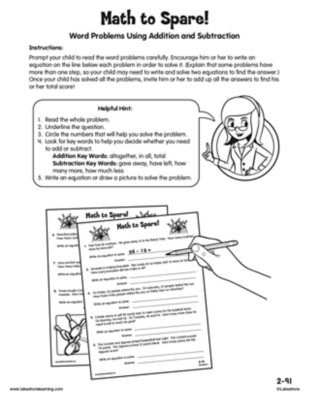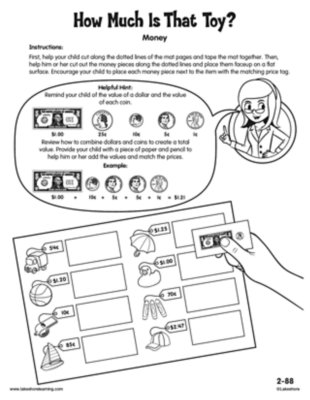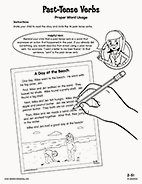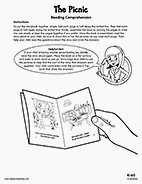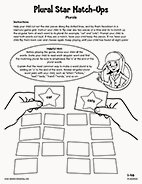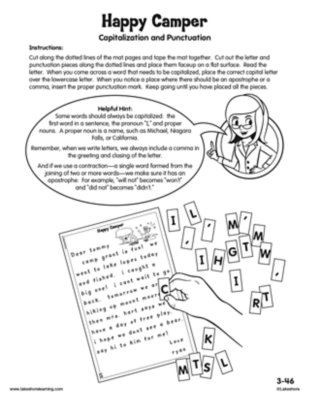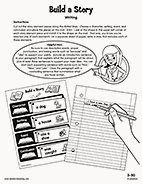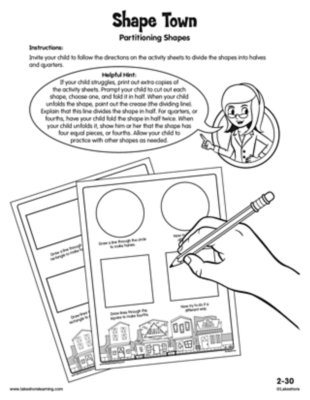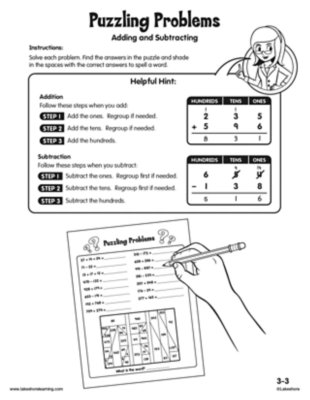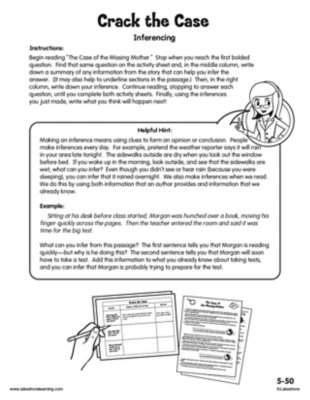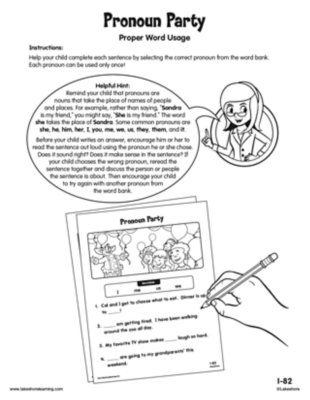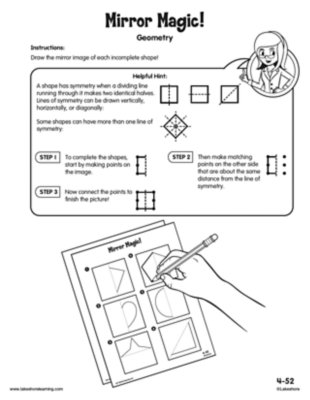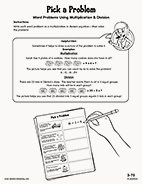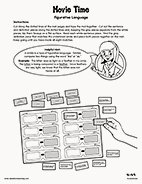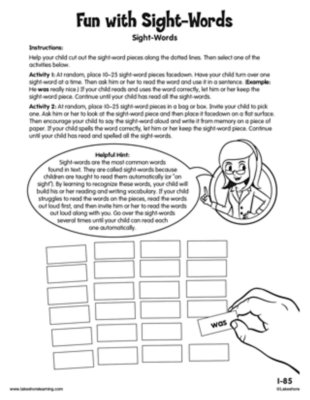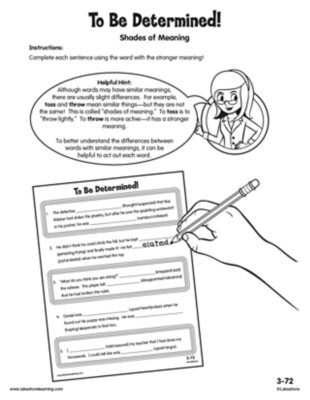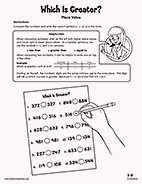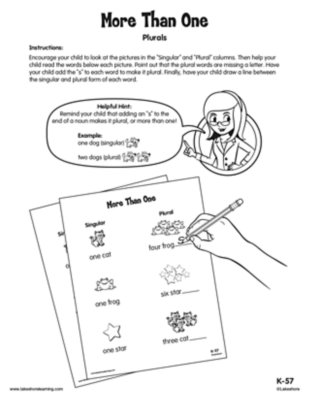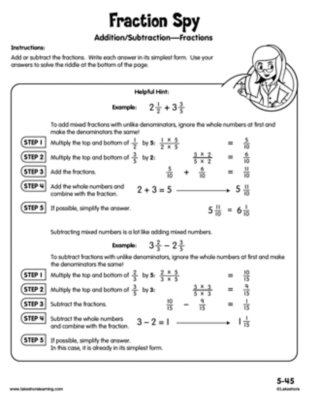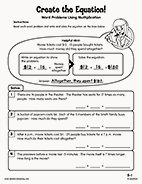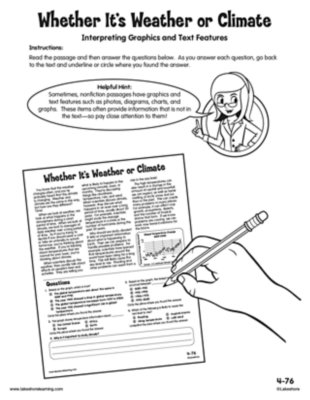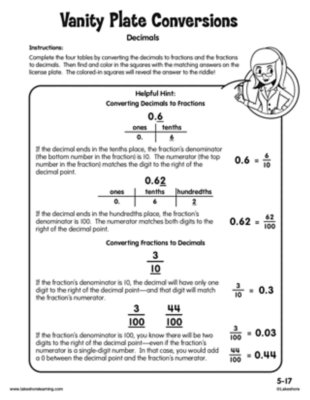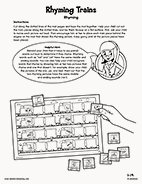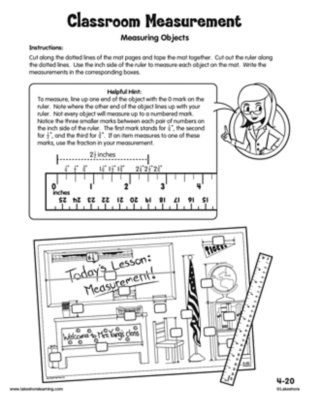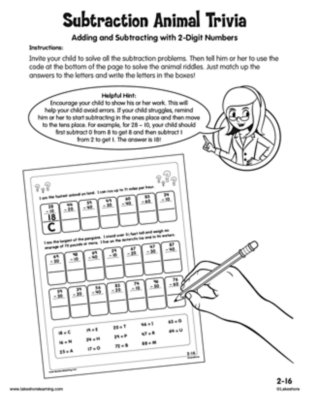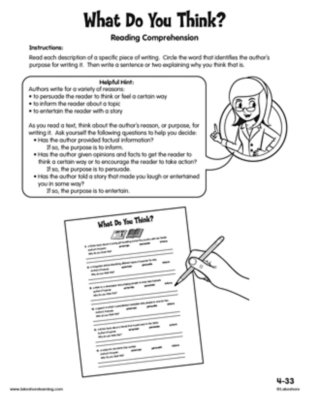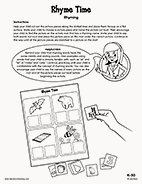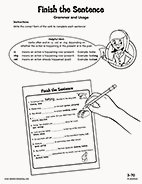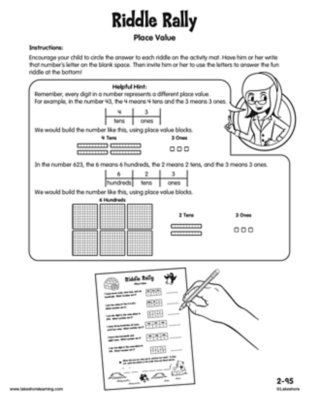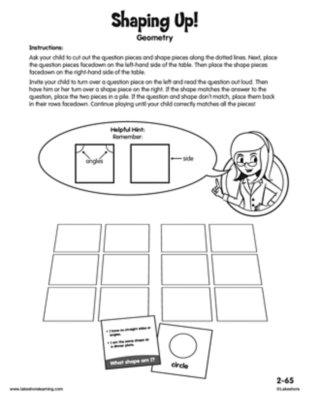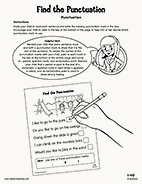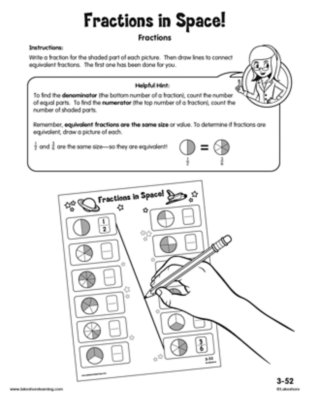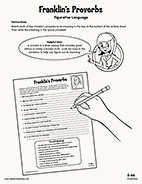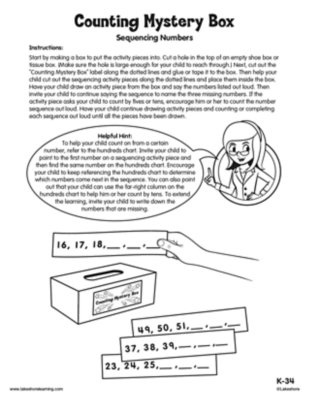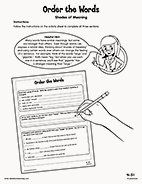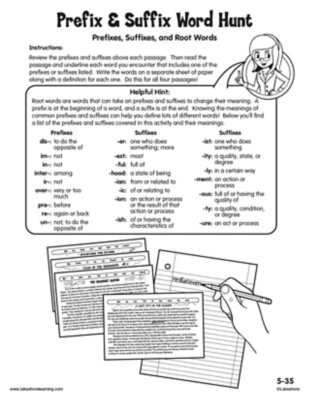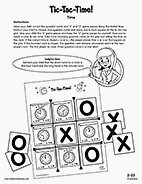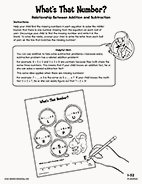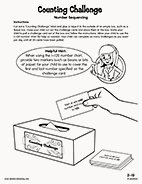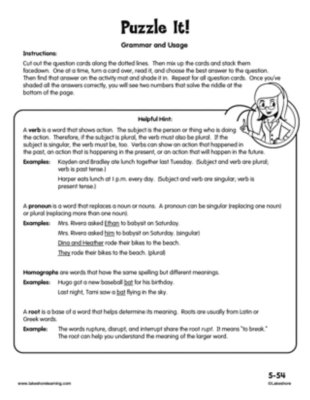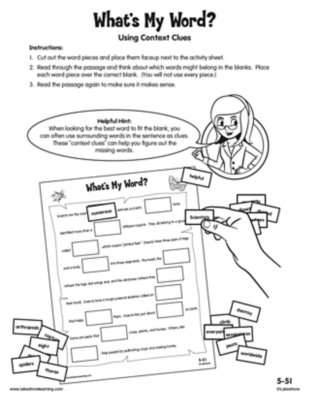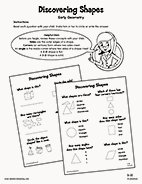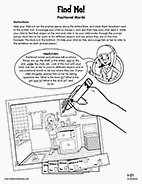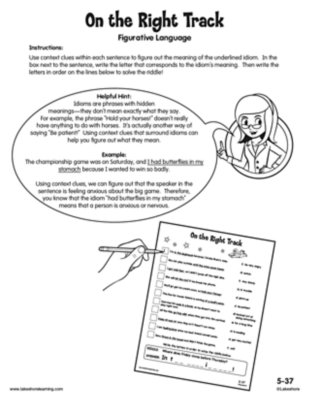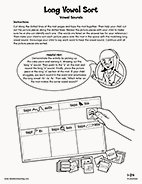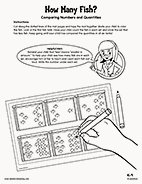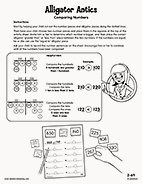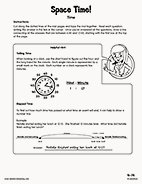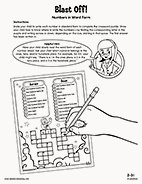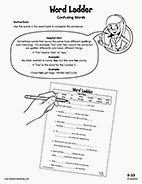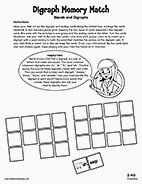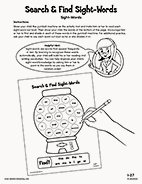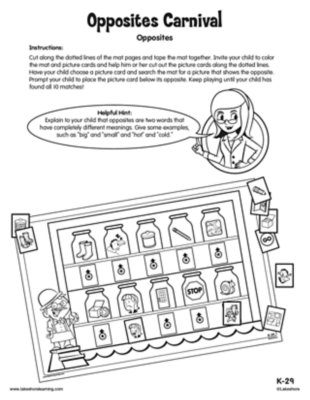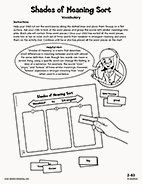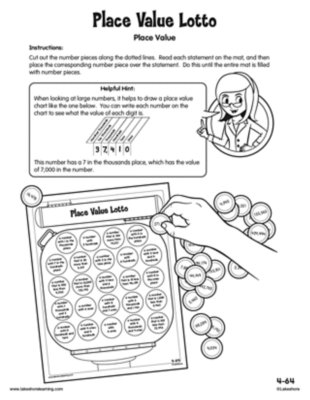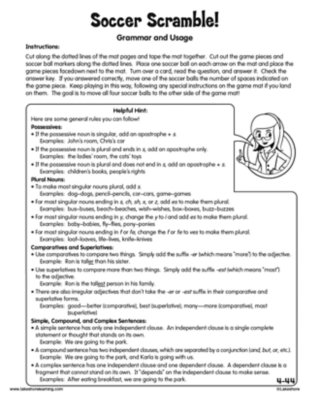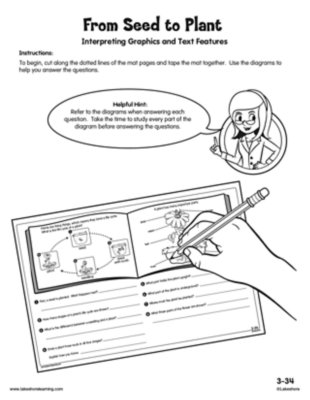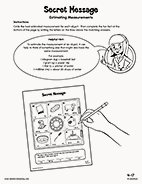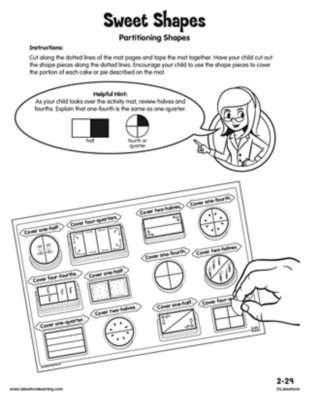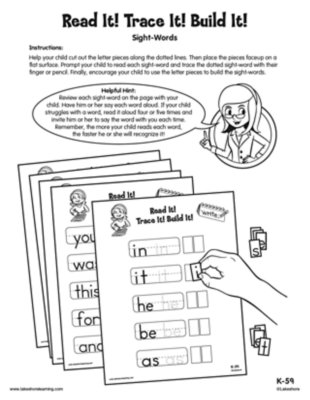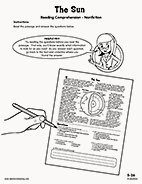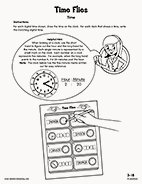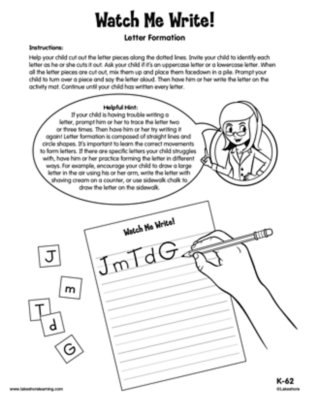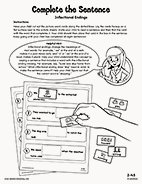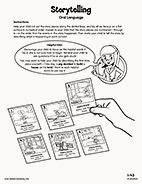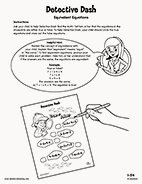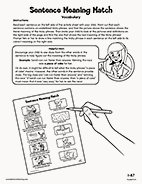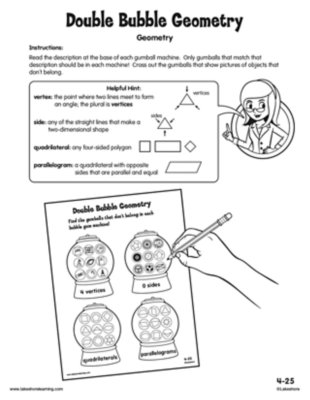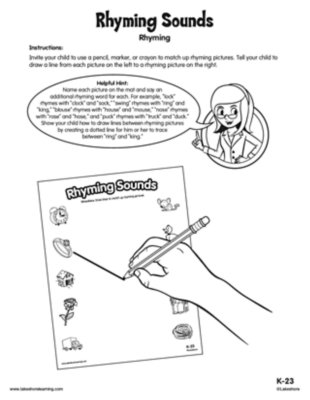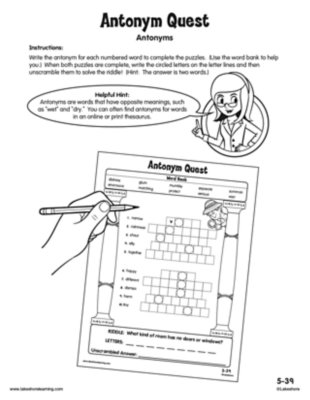Narrow by Grade
Grade
0 results for "sand/" , here are results for "and"
When entering third grade, your child should be able to recognize and draw shapes with specific attributes, such as six angles or three sides. Your child should also be able to identify triangles, quadrilaterals, pentagons, hexagons and cubes.
View worksheetDuring kindergarten, your child will learn to identify the ending sounds in simple words and identify the letter that makes them, such as identifying the “n” sound in “pen.”
View worksheetWhen entering first grade, your child should be able to count and say the syllables in spoken words. For example, your child should understand that “kitten” has two syllables: kit•ten.
View worksheetDuring fourth grade, your child will learn about factors, which are numbers that can be multiplied together to reach another number. For example, the factors of 6 are 1 and 6 (1 x 6 = 6), as well as 2 and 3 (2 x 3 = 6). Your child will also learn about multiples, which are numbers that are reached by multiplying one number by another. 12 is a multiple of 3 because you can multiply 3 x 4 to reach 12.
View worksheetDuring first grade, your child will learn that addition and subtraction are closely related. For example, your child will solve the problem 10 — 2 = ? by understanding that 8 + 2 = 10.
View worksheetDuring first grade, your child will learn to recognize common spelling patterns, such as those found in rhyming words like “cat/rat/bat” and “run/fun/sun.”
View worksheetDuring third grade, your child will learn to understand figurative language, such as idioms, and distinguish between the literal and nonliteral meanings of words. For example, “It was a piece of cake!”
View worksheetWhen entering second grade, your child should be able to tell and write time in hours and half-hours using clock faces and digital clocks.
View worksheetWhen entering kindergarten, your child should be able to recognize numbers 1 to 20 and count them in sequence.
View worksheetWhen entering fourth grade, your child should know how to correctly use words in sentences and should know many rules of English grammar, including parts of speech, regular and irregular plural nouns, regular and irregular verbs, verb tenses, subject-verb agreement, sentence structure and more.
View worksheetWhen entering fifth grade, your child should be able to compare and round multidigit numbers. Your child should also be able to read and write multidigit numbers in number, word and expanded form. For example, 765; seven hundred sixty-five; 700 + 60 + 5.
View worksheetWhen entering kindergarten, your child should be able to recognize and name some lowercase letters, especially those in your child’s name.
View worksheetWhen entering kindergarten, your child should be able to listen to a story and ask and answer questions about key details, such as identifying characters and events and retelling the story in their own words. Your child should also understand the basic features of print, such as differentiating letters from words, recognizing that words have spaces between them and distinguishing the roles of authors and illustrators.
View worksheetWhen entering third grade, your child will be expected to know many rules of English grammar and usage, including how to correctly use adjectives, adverbs, pronouns, past-tense verbs and plural words.
View worksheetWhen entering third grade, your child should be able to decode—or read and understand—two-syllable words by applying word analysis skills and by sounding out words.
View worksheetDuring second grade, your child will learn to tell and write time from clock faces and digital clocks to the nearest five minutes. For example, 8:05 a.m. or 2:15 p.m.
View worksheetWhen entering second grade, your child should be able to subtract within 20 fluently. For example, 18 — 5 = 13 and 20 — 6 = 14.
View worksheetWhen entering fourth grade, your child should understand fractions as numbers and be able to represent fractions on a number line, compare fractions and identify equivalent fractions.
View worksheetDuring second grade, your child will learn to tell and write time from clock faces and digital clocks to the nearest five minutes. For example, 8:05 a.m. or 2:15 p.m.
View worksheetDuring second grade, your child will learn to solve one- and two-step word problems involving addition and subtraction within 100.
View worksheetDuring second grade, your child will count dollar bill and coin combinations.
View worksheetWhen entering second grade, your child should be able to correctly use pronouns, singular and plural words, and past-, present- and future-tense words in sentences.
View worksheetDuring kindergarten, your child will be asked to listen to a story and answer questions about key details, including identifying characters and events and retelling the story in sequence.
View worksheetWhen entering first grade, your child should be able to form regular plural nouns when speaking by adding -s or -es. For example, “dog/dogs” and “wish/wishes.”
View worksheetDuring kindergarten, your child will learn to identify beginning sounds in words and name the letter that makes them, such as identifying the “b” sound in “bat.”
View worksheetWhen entering third grade, your child should remember to capitalize holidays, product names and geographic names. Your child should also use commas in the greetings and closings of letters and use apostrophes in contractions and possessives, such as “Jeff’s bike.”
View worksheetWhen entering third grade, your child should be able to write a paragraph with an opening, three or more details and a closing.
View worksheetWhen entering fifth grade, your child should be able to identify lines and angles, measure angles, understand symmetry and classify shapes based on their lines and angles. For example, your child should be able to classify right triangles by seeing that they have a 90-degree angle.
View worksheetWhen entering second grade, your child should be able to divide circles and rectangles into halves and fourths and describe the parts of each using words like “halves,” “fourths” and “quarters.”
View worksheetWhen entering third grade, your child should be able to add and subtract two 3-digit numbers (327 + 216 or 452 — 318), add multiple 2-digit numbers (22 + 14 + 36 + 61) and find the missing number in equations (14 + __ = 19).
View worksheetDuring fifth grade, your child will learn to make inferences when reading fiction and nonfiction text passages, citing places in the text that led your child to draw certain conclusions.
View worksheetDuring first grade, your child will learn subtleties in words’ meanings and make real-life connections between words and their use, such as understanding that both a bed and sofa could be called cozy.
View worksheetDuring fourth grade, your child will learn to identify lines and angles, understand symmetry and classify shapes based on their lines and angles. For example, your child will be able to classify right triangles by seeing that they have a 90-degree angle.
View worksheetDuring third grade, your child will learn to solve word problems involving multiplication and division within 100.
View worksheetWhen entering fourth grade, your child should understand figurative language, such as idioms, and be able to distinguish between the literal and nonliteral meanings of words. For example, “It was a piece of cake!”
View worksheetDuring first grade, your child will learn to spell frequently occurring irregular words, such as “know” and “could,” and learn to recognize and read them on sight.
View worksheetWhen entering third grade, your child should be able to solve problems using information from line plots, picture graphs and bar graphs.
View worksheetWhen entering third grade, your child should be able to mentally add 10 or 100 to any given number from 100 to 900 without having to write down the problems and work them out. For example, 156 + 10 = 166 and 234 + 100 = 334.
View worksheetDuring third grade, your child will be expected to distinguish between shades of meaning among related words—such as “wondered,” “suspected,” “believed” and “knew”—and sort the words in order from the weakest to the strongest meaning.
View worksheetWhen entering third grade, your child should understand that the three digits in a three-digit number represent hundreds, tens and ones. Your child should also be able to write three-digit numbers in expanded form, such as writing 726 as 700 + 20 + 6. Your child should also be able to compare two 3-digit numbers using the greater than (>), less than (<) and equal to (=) symbols.
View worksheetDuring kindergarten, your child will learn to form regular plural nouns when speaking by adding -s or -es. For example, “dog/dogs” and “wish/wishes.”
View worksheetDuring fifth grade, your child will learn to add and subtract fractions with different denominators. For example, 1/3 + 1/4 = 4/12 + 3/12 = 7/12.
View worksheetWhen entering fifth grade, your child should be able to multiply and divide to solve word problems and be able to solve multistep word problems that involve multiplication and division.
View worksheetDuring fourth grade, your child will learn to interpret information from charts, graphs, diagrams, time lines, animations and interactive Web pages, and explain how that information helps them understand a text.
View worksheetWhen entering fifth grade, your child should be able to compare decimals to the hundredths place, such as 0.45 and 0.07. Your child should also be able to write fractions with denominators of 10 or 100 as decimals, such as writing 3/10 as 0.3 and writing 34/100 as 0.34.
View worksheetWhen entering first grade, your child should be able to recognize and create rhyming sounds.
View worksheetWhen entering fourth grade, your child should be able to measure the lengths of objects using rulers marked with halves and fourths of an inch.
View worksheetWhen entering second grade, your child should be able to add and subtract using a two-digit number and a one-digit number, as well as a two-digit number and another two-digit number. For example, 22 + 20 = 42 and 41 — 10 = 31.
View worksheetWhen entering fourth grade, your child should be able to read and analyze level-appropriate stories, dramas, poems and informational texts, identifying elements such as main ideas, key details and the author’s purpose.
View worksheetDuring kindergarten, your child will learn to recognize and create rhyming words.
View worksheetDuring third grade, your child will learn many new rules of English grammar and usage, including rules about parts of speech, regular and irregular plural nouns, regular and irregular verbs, verb tenses, subject-verb agreement, sentence structure and more.
View worksheetDuring second grade, your child will learn to identify groups of hundreds, tens and ones when counting. Your child will also learn that the three digits in a three-digit number represent hundreds, tens and ones. For example, there are 7 hundreds, 2 tens and 6 ones in the number 726.
View worksheetWhen entering second grade, your child should be able to add to 20 fluently. For example, 5 + 9 = 14 and 13 + 7 = 20.
View worksheetDuring second grade, your child will learn to recognize shapes and identify their attributes, such as how many sides, angles or vertices (corners) they have. Your child will also learn to divide circles and rectangles into halves, thirds and fourths.
View worksheetWhen entering first grade, your child should understand that sentences begin with a capital letter and that the word “I” is also capitalized. Your child should also be able to recognize and name the punctuation marks at the end of sentences, including periods, question marks and exclamation points.
View worksheetDuring third grade, your child will learn to compare fractions and represent whole numbers as fractions. For example, 4/4 = 1 whole and 3/1 = 3 wholes.
View worksheetDuring fifth grade, your child will learn to interpret examples of figurative language, including similes and metaphors, based on the context in which they are used. Your child will also learn to recognize and explain the meaning of common idioms and familiar sayings and expressions, such as, “A bird in the hand is worth two in the bush.”
View worksheetDuring kindergarten, your child will learn to count in sequence from 1 to 100 by ones (1, 2, 3, 4…) and tens (10, 20, 30, 40…).
View worksheetWhen entering fourth grade, your child should be able to distinguish between shades of meaning among related words, such as “wondered,” “suspected,” “believed” and “knew.”
View worksheetWhen entering fifth grade, your child should be able to use common, grade-appropriate Greek and Latin prefixes, suffixes and roots to figure out the meaning of a word. For example, “telegraph,” “photograph” and “autograph” all contain the Greek root “graph,” which refers to something that is written or drawn.
View worksheetWhen entering second grade, your child should be able to tell and write time in hours and half-hours using clock faces and digital clocks.
View worksheetDuring first grade, your child will learn that addition and subtraction are closely related. For example, your child will solve the problem 10 — 2 = ? by understanding that 8 + 2 = 10.
View worksheetWhen entering second grade, your child should be able to count, read and write numbers up to 120, beginning with any number. For example, 116, 117, 118, 119, 120.
View worksheetDuring third grade, your child will learn to read and analyze level-appropriate stories, dramas, poems and informational texts, identifying elements such as key events and details, the main idea and the theme or moral.
View worksheetDuring fifth grade, your child will learn many new rules of English grammar and usage, including how to correctly use verb tenses, conjunctions and prepositions in sentences. Your child will also learn new rules about the correct use of punctuation and capitalization when forming sentences and paragraphs.
View worksheetDuring fifth grade, your child will learn to figure out the meaning of an unfamiliar word or phrase by using clues in the text, such as cause/effect relationships and comparisons. For example, in the following sentence, you can determine that the word “chastened” means “punished” by looking at the cause and effect: “When Judy found out that her son had cheated, she chastened him by taking away his video games.”
View worksheetWhen entering first grade, your child should be able to identify 2-D (flat) and 3-D (solid) shapes, find shapes in the real world and compare shapes based on their number of sides or corners.
View worksheetWhen entering first grade, your child should be able to correctly use positional words, such as “above” and “between.”
View worksheetWhen entering fifth grade, your child should be able to figure out the meaning of figurative language, including similes, metaphors and idioms.
View worksheetWhen entering first grade, your child should know the long and short vowel sounds for the five major vowels (a, e, i, o and u).
View worksheetWhen entering kindergarten, your child should be able to count groups of up to 10 objects and determine if one group of objects is more than, less than or equal to the other.
View worksheetDuring second grade, your child will learn to determine if a three-digit number is greater than, less than or equal to another three-digit number and use the >, < and = symbols to show the answer.
View worksheetWhen entering fourth grade, your child should know how to tell and write time to the nearest minute. Your child should also be able to solve problems in which time has elapsed. For example, “The movie started at 5:15 p.m. It was 1 hour and 20 minutes long. What time did the movie end?”
View worksheetWhen entering second grade, your child should be able to read a number up to one hundred and write its corresponding numeral. For example, forty-one = 41.
View worksheetWhen entering fifth grade, your child should be able to correctly use frequently confused words, such as “to” and “two” or “there” and “their.”
View worksheetWhen entering second grade, your child should be able to read and spell words with consonant blends, such as “st,” “sp” and “bl,” as well as common consonant digraphs, such as “th,” “ch” and “sh.”
View worksheetWhen entering first grade, your child should be able to read common, high-frequency words by sight, such as “the,” “of,” “to” and “you.”
View worksheetWhen entering kindergarten, your child should be able to understand the most common opposites, such as “happy/sad” and “stop/go.”
View worksheetDuring second grade, your child will build vocabulary and learn to distinguish shades of meaning among closely related words, such as “toss,” “throw” and “hurl” or “thin,” “slender” and “skinny.”
View worksheetDuring fourth grade, your child will learn to identify the value of each digit in a multidigit number. Your child will also learn to read and write multidigit numbers in number, word and expanded form. For example, 765; seven hundred sixty-five; 700 + 60 + 5.
View worksheetWhen entering fourth grade, your child should know how to correctly use words in sentences and should know many rules of English grammar, including parts of speech, regular and irregular plural nouns, regular and irregular verbs, verb tenses, subject-verb agreement, sentence structure and more.
View worksheetWhen entering third grade, your child should be able to use text features—including diagrams, bold print, glossaries and indexes—to locate facts in informational texts, such as newspapers, magazines or science books.
View worksheetWhen entering fourth grade, your child should be able to estimate liquid volumes and masses of objects using grams, kilograms and liters.
View worksheetWhen entering second grade, your child should be able to divide circles and rectangles into halves and fourths and describe the parts of each using words like “halves,” “fourths” and “quarters.”
View worksheetDuring kindergarten, your child will learn to read common, high-frequency words by sight, such as “the,” “of,” “to” and “you.”
View worksheetWhen entering fifth grade, your child should be able to read, analyze and understand level-appropriate nonfiction reading passages, finding the main idea and important details, comprehending key words and phrases, comparing different accounts of the same event or topic and making inferences.
View worksheetWhen entering third grade, your child should be able to tell and write time from clock faces and digital clocks to the nearest five minutes. For example, 8:05 a.m. or 2:15 p.m.
View worksheetDuring kindergarten, your child will learn to print uppercase and lowercase letters.
View worksheetWhen entering second grade, your child should be able to read words with inflectional endings and use them correctly in sentences. Inflectional endings are letters that are added to words, such as “-ing,” “-es,” or “-ed.” For example, your child should be able to read the words “wishing,” “wishes” and “wished” and use them correctly in sentences.
View worksheetWhen entering first grade, your child should be able to describe familiar people, places, things and events and express their thoughts, feelings and ideas clearly.
View worksheetDuring first grade, your child will learn what the equal sign means, identify whether equations are true or false and complete equations by finding missing numbers.
View worksheetDuring first grade, your child will learn to figure out the meanings of new words and multiple-meaning words based on the context in which they are used.
View worksheetWhen entering fourth grade, your child should understand that different types of shapes can share the same attributes. For example, rhombuses, rectangles and squares all have four sides and are part of a larger group called quadrilaterals.
View worksheetWhen entering third grade, your child should understand that the three digits in a three-digit number represent hundreds, tens and ones. Your child should also be able to write three-digit numbers in expanded form, such as writing 726 as 700 + 20 + 6. Your child should also be able to compare two 3-digit numbers using the greater than (>), less than (<) and equal to (=) symbols.
View worksheetWhen entering kindergarten, your child should be able to recognize and match words that rhyme.
View worksheetWhen entering fifth grade, your child should be able to understand words by relating them to their opposites (antonyms) and to words with similar but not identical meanings (synonyms).
View worksheet